The A-Z Pest Guide provides detailed information on all sorts of garden pests, including affected plants, types of damage caused, and various methods of pest control, including biological and organic methods.
An alphabetical listing of common garden pests and their remedies |
|
 |
Heirloom seeds are the gardeners choice for seed-saving from year-to-year. Learning to save seeds is easy and fun with these books. Before you harvest, consider which varieties you might want to save seeds from so that your harvesting practice includes plants chosen for seed saving. Be sure to check out our newest seed packs, available now from Heirloom Organics. The Super Food Garden is the most nutrient dense garden you can build and everything you need is right here in one pack. The Genesis Garden s a very popular Bible Garden collection. The Three Sisters Garden was the first example of companion planting in Native American culture. See all of our brand-new seed pack offerings in our store.
|
Not every garden, flower, or plant will face all of these threats, but every gardener will have to deal with some of them at one time or another, so it pays to be prepared by reading about the common pests below.
Ants
 Studying ants is a lesson in survival. If ants encounter a substance that kills them or forms a barrier, they set to work and pile up enough of each other, dead or alive, to make a bridge to cross. Studying ants is a lesson in survival. If ants encounter a substance that kills them or forms a barrier, they set to work and pile up enough of each other, dead or alive, to make a bridge to cross.
There are over 14,000 ant species worldwide. Some are useful as biological control in farming, many have painful bites and some eat crops. Controlling ants in the garden is the focus here, so whether you have brown coastal ants, bull ants or tiny black ants, most of them continually scout around searching for food and if you see one, it's probably left a scent trail and in a flash the rest of the team will be on their way.
In your vegetable garden ants 'farm' aphids, even moving aphids to put them on better plants. The ants collect the sweet honeydew that aphids secrete after sucking plant sap. Mealy bugs and scale are other soft-bodied insects that secrete honeydew which ants collect. The ants make tunnels and nests in your soil and undermine roots and really roughshod it over everything in your garden if they get out of hand.
You have to be crafty to totally get rid of ants. Some instant ant ammunition...
Borax can be used as a natural insecticide, although must be kept away from children, pets and protect yourself too. Watch your eyes, nose, use gloves and wash hands afterwards. Borax mixed with peanut butter or something sweet, such as honey, means the ants eat it and take it back to their nest to share with other ants, hopefully poisoning all in the nest.
Diatomaceous earth sprinkled on ants' trails kills ants by dehydration when they're back in their nest.
Garlic fire spray will kill ants on contact... but there's plenty more on their way!
There are lots of organic garden pest control deterrent for ants, but keep applying and changing them because they are determined little blighters indeed. When ants are under attack, some ants will gather a few eggs and move to another location, so often all you achieve is for them to move their nest somewhere else, in which case unless they become a pest again, leave them in peace.
Some more ant strategies...
Dab some jam, honey or sugar water (and borax if you wish) on the base of aphid infested plants. That will hold the ants back whilst you set some ladybugs on the aphids. You can spray the aphids and ants, but the ants will have a store of eggs underground and will soon move back to start farming again.
Cucumber peels on ant routes will send them away for a while.
If you find the ants' nest, make them disappear by sprinkling in or near their entrance one or more of these: black pepper, cayenne pepper, cinnamon or chilli powder. Likewise salt sends them into a frenzy.
Boiling water can then be poured on as many ants as you can reach (as long as it's safe and away from plants).
Boiling water can of course be poured down an ant nest to kill the queen — if you are lucky enough to find an easy to reach nest, but usually they are very deep and constructed to stop rain and flooded water going in.
Aphids
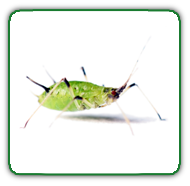 Rhubarb leaves are semi-poisonous to aphids, and a tea brewed from rhubarb leaves poisons smaller critters, such as mites, white fly, caterpillars etc. Pour boiling water over crushed rhubarb leaves then leave to soak for several days. Strain, add a good squirt of detergent and dilute enough so that it looks like weak tea and spray over pest infested plants. Repeat every 10 days or so. Rhubarb leaves are semi-poisonous to aphids, and a tea brewed from rhubarb leaves poisons smaller critters, such as mites, white fly, caterpillars etc. Pour boiling water over crushed rhubarb leaves then leave to soak for several days. Strain, add a good squirt of detergent and dilute enough so that it looks like weak tea and spray over pest infested plants. Repeat every 10 days or so.
Also try the garlic/chilli sprays above.
Birds
 Most birds are insect eaters and will leave plants alone, especially in the breeding season when they are heavy protein eaters. Most birds are insect eaters and will leave plants alone, especially in the breeding season when they are heavy protein eaters.
Okay, it does happen that some birds rip leaves to threads, demolish berries, scatter garden matter far and wide and gouge great holes in your soil.
Certain birds, such as pigeons, parrots and lorikeets, can adopt you. Feed one or two and suddenly the sky's full of them all homing into your place! They don't attack your plants, but can make a mess and ruin railings, porches, roofs and such like.
Here are some tactics to utilize:
Visual scare tactics for natural bird control
- Shiny things: String old CDs around the patches of garden where you have planted seedlings for example. Those birds such as blackbirds, that scatter things far and wide, will be wary of the reflective movement.
- Other shiny stuff, such as festive paper and decorations, bottle tops, old utensils, tins and foil are also effective. Use the foil lids from dip and yogurt containers, and don't throw out any foil you used to bake dinner with.
- Make a scarecrow: Only feasible if you have the time, space, and especially helpful children.
- Snakes: A rubber toy snake or one of those sand filled ones gives excellent pest control. Birds will shy away instead of landing if you put a fake snake in a visible place.
- Hunters and predatory birds: A large cutout or kite of a hunter type of bird, such as a hawk or owl, can keep smaller birds away. Nobody likes bullies, even birds. Sit your fearsome picture in a nearby tree or attach to a pole, fence, house or on wire or twine across garden.
- Cats and dogs: Having pets doesn't always guarantee the birds will stay away. Anyway, most people that like pets, like birds, so it's back to that mutual understanding of community, jungle type rule of sharing, squaring off and semi-co-existing.
But... here again, a mock puddy tat, especially if larger than life, painted shiny jet black with piecing green or gold eyes, can do the trick. Lean Leo against the nearby fence or pea trellis and move him around often.
How about joining your local night class in woodworking to make your own bird pest control cat — or two?
Electronic bird control and other noises
- Big bang: You don't have to create the universe again, just move a few birds along. Make a sudden loud bang or sharp crack. Do this a few times, especially when pigeons are settling down for a nap and they'll get the message and find another guesthouse. (I know it's cruel, but as the saying goes: You have to be cruel to be kind... in this case to you).
- Ultrasonic bird repellers: Unless you're a DIY enthusiast with an electrical bent, then you'll have to buy these online or from a garden centre. These bird repellers emit regular pitched sounds, such as distress calls, predator cries or general scary noises that humans usually can't hear, but will frighten birds and animals away.
Physical bird pest control
- Bird spikes: These are probably the most common type of natural bird repellants and popular with boaties to stop seagulls and cormorants from messing up their... well, boats.
For your garden — along fence tops, edges or railings, you can try homemade varieties, but they don't usually look pretty. Nails sticking up from wood, cut plastic or tin — you or your family might get hurt, or goodness — an unwary burglar climbing over your porch rail.
There are lots of types to choose from in shops and online and they can be made from clear, unobtrusive polycarbonate, which doesn't rust or hurt anyone. The birds just can't land or if they do, they get their feet all in a tither.
- Bird netting: You can make netting frames to place over fruit and vegetables that are ripening. Frames are a bit of a nuisance to store, but easy to lift and gobble a strawberry or two... or ten.
Wire or cloth netting is ok to place over plants, but watch out that the plants haven't grown through it and you don't rip them out of the ground when you shift the netting.
There is some concern that string netting can tangle birds' feet and even friendly snakes, in which case stick with the wire netting or use fine mesh netting attached to high frames.
- Timed sprinklers: These are good. You wouldn't hang around either would you, if you got hosed down whilst in the middle of breakfast?
- Garlic Fire Spray: This will deter birds if selectively used on the edge of certain precious areas.
- Harmless sticky gels: Commercial gels can be bought to use as bird pest control, or make your own either using petroleum jelly or heavy engine oil.
Spread on the oil to keep birds off garden borders, such as wood, bricks etc, or on top of fences, certain branches, gutterings or railings. Birds hate it so it's rather effective, although eventually gets messy.
Caterpillars
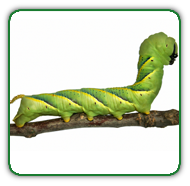 To discourage moths and grubs on corn, fruit, brassicas (includes broccoli, spinach, cabbage, cauliflower, Brussels sprouts, kale, collard greens, pak choi and kohlrabi) simply spray with a molasses blend. Mix one tablespoon of molasses with a litre of hot water. Then add a teaspoon of liquid detergent and put in a spray bottle. Spray the leaves, top and bottom, about once a week. To discourage moths and grubs on corn, fruit, brassicas (includes broccoli, spinach, cabbage, cauliflower, Brussels sprouts, kale, collard greens, pak choi and kohlrabi) simply spray with a molasses blend. Mix one tablespoon of molasses with a litre of hot water. Then add a teaspoon of liquid detergent and put in a spray bottle. Spray the leaves, top and bottom, about once a week.
An alternative to the molasses spray is a blend of 1 part vinegar to 3 parts water. Add a teaspoon of liquid detergent and put in a spray bottle. Spray the leaves, top and bottom to kill off grubs and bugs.
Also see Garlic fire spray at the top and Rhubarb spray under Aphids.
Cats
 Lots of gardeners have cats and that's nice. You can't expect cats to be nice and do what you want them to do, where you want them to do it. They will do what they want to, paw the soil around then have a snooze on top of your seedlings. Cats like a nice bit of loose soil, so mulch like mad and if you can provide a dirt patch or box somewhere else for use, you may be lucky and train them to use that. Lots of gardeners have cats and that's nice. You can't expect cats to be nice and do what you want them to do, where you want them to do it. They will do what they want to, paw the soil around then have a snooze on top of your seedlings. Cats like a nice bit of loose soil, so mulch like mad and if you can provide a dirt patch or box somewhere else for use, you may be lucky and train them to use that.
If you're done being nice or it's your neighbour's cats being bad-mannered — a fright or two with a hose often works. Interestingly a cat that purrs on your lap at your neighbour's house, will be completely different in your garden. Cats are hunters, and they are wary themselves outdoors.
You won't be able to get close enough to hurt them with water, but you can make them unwelcome. A direct hit amidships from 20ft away is harmless, or keep a water filled soda bottle with a hole in the cap handy or child's water pistol to squirt at them. Save your citrus peel, especially orange, and cut it up or run over a pile with the lawnmower. Scatter it around garden edges and keep topping up. Cats thoroughly dislike citrus. The Garlic fire spray works around garden edges, but you'll go through an awful lot of it, all the time, everywhere you need it, to keep cats away. Miss a corner or forget to spray where they land from the fence next door, and they're in!
Deer
 Deer are the most difficult of all pests to deter from a garden. They love many different plants. Flowers, vegetables, trees and shrubs are all on their menu. Deer are the most difficult of all pests to deter from a garden. They love many different plants. Flowers, vegetables, trees and shrubs are all on their menu.
The best way to keep deer out of a garden is by using a fence that is at least 6 feet high. If it's a small garden that may be feasible but for large gardens or yards, the cost is prohibitive, or possibly not practical.
So the only other choice is deterrents.
Deer don't like the smell of raw eggs, fish products, kelp, or ammonia. Any spray made from these products can be used. Just mix the product of choice in water and spray the plants to be protected.
Deer don't like the smell of soap either. Some gardeners have especially found success with Dial and Zest brands.
Blood meal scattered around the garden is another good deterrent.
Since deer don't like capsaicin, the ingredient that makes peppers hot, a spray made from chili peppers deters deers.
Hang fragrant fabric-softener strips, and small nylon bags filled with human hair on trees around the garden.
Some gardeners have found success by laying chicken wire on the ground about six feet wide around the perimeter of the garden. The deer don't like to walk on it because their hooves get stuck in the loops of the wire.
Try planting time-released garlic capsules at the bases of trees or shrubs or in the rows of plants to be protected.
There is a wide variety of plants that deer won't eat. A list of what they like and don't like can be obtained from your local county cooperative extension office.
Dogs
 This is a hairy one. Apart from providing a shady spot somewhere else instead of between your lettuce rows, a soft bit of lawn or soil to roll around on rather than your seedlings, a bone to chew instead of nibbling your peas, and the most horrible face and voice you can conjure up should the bone look like it might be buried in the potato patch... then give up, or put up a fence. This is a hairy one. Apart from providing a shady spot somewhere else instead of between your lettuce rows, a soft bit of lawn or soil to roll around on rather than your seedlings, a bone to chew instead of nibbling your peas, and the most horrible face and voice you can conjure up should the bone look like it might be buried in the potato patch... then give up, or put up a fence.
Earwigs
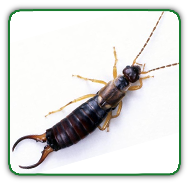 If earwigs are eating your plants, crumple some newspaper in old flower pots and leave them in the garden. The earwigs will hide in the paper once they're done eating. In the morning, shake the paper out where they can have a new home or into a bucket of hot water if earwigs aren't your cup of tea. If earwigs are eating your plants, crumple some newspaper in old flower pots and leave them in the garden. The earwigs will hide in the paper once they're done eating. In the morning, shake the paper out where they can have a new home or into a bucket of hot water if earwigs aren't your cup of tea.
Fleas
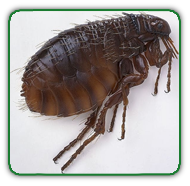 There are whole websites devoted to killing fleas in the home, so here we'll just deal with fleas in the garden. To deter fleas outside use diatomaceous earth and sprinkle it on your shoes and socks as you step into the garden. This way those fleabags won't hitch a ride back inside with you. DE consists of vast amounts of microscopic fossilized, broken down diatoms. It looks like flour and is harmless to animals and humans. It kills small insects and bugs by cutting into their surface, thus causing dehydration. It's often used in grain silos so is available in farmers' stores as well as some health outlets. It's ok for you and pets to ingest diatomaceous earth as it kills parasites, but it is a very fine powder so avoid breathing it in. Pennyroyal (sometimes called stinking roger) grown near the door and in the garden gets rid of fleas. There are pennyroyal pet soaps and washes that are sold to protect pets from fleas. There are whole websites devoted to killing fleas in the home, so here we'll just deal with fleas in the garden. To deter fleas outside use diatomaceous earth and sprinkle it on your shoes and socks as you step into the garden. This way those fleabags won't hitch a ride back inside with you. DE consists of vast amounts of microscopic fossilized, broken down diatoms. It looks like flour and is harmless to animals and humans. It kills small insects and bugs by cutting into their surface, thus causing dehydration. It's often used in grain silos so is available in farmers' stores as well as some health outlets. It's ok for you and pets to ingest diatomaceous earth as it kills parasites, but it is a very fine powder so avoid breathing it in. Pennyroyal (sometimes called stinking roger) grown near the door and in the garden gets rid of fleas. There are pennyroyal pet soaps and washes that are sold to protect pets from fleas.
Gophers (Also see Moles & Voles)
 Here's a few tricks to try to deter gophers: Here's a few tricks to try to deter gophers:
- Encourage birds of prey by putting water bird baths in garden and keeping foliage around the garden edge down so the birds can spot any such rodents.
- Lay mesh around your garden edge at least 45cm (18") deep. Some gardeners even lay it on the bottom of a garden bed.
- Have some pets, such as a dog or even a cat, and make sure they are out and about during dawn and dusk at the same time as gophers get active. Gophers and other burrowing creatures will avoid trespassing where there are family pets in sight.
- Spraying with Garlic fire works but depending on garden size it may be too big a task and too expensive to make enough and keep using it.
- If you already have a few gopher holes, put the hose down them and flood their tunnels.
Mealy bugs
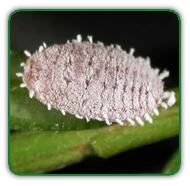 Treat these soft pale pink, white or gray sucking insects the same way as scale. Indoor plants are susceptible to mealy bugs because of the sheltered environment, so in your garden mealy bugs love glass houses and plants growing near or under weather protection. Treat these soft pale pink, white or gray sucking insects the same way as scale. Indoor plants are susceptible to mealy bugs because of the sheltered environment, so in your garden mealy bugs love glass houses and plants growing near or under weather protection.
Mealy bugs multiply rapidly and will soon sap the life of a plant, causing distortion and stunted growth first. They are easy to squish with fingers or dab with a cotton bud dipped in methylated spirits. They have a slight waxy coating so anything that burns this off, such as meths, causes death by dehydration. Smothering with oil is also effective.
Mice
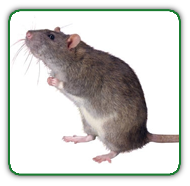 If they get into your home from the garden, smarten up your housekeeping to the point of being fanatical. Don't leave food out, put stored food in containers and empty the crumb tray of your toaster. If they get into your home from the garden, smarten up your housekeeping to the point of being fanatical. Don't leave food out, put stored food in containers and empty the crumb tray of your toaster.
Deter mice with peppermint or eucalyptus oil – soak cloths or cottonwool and put where mice come in or have been. They tend to go around edges and under appliances, so concentrate your efforts there and if you have to lay traps, bait them with peanut butter, cheese, stiff porridge or bread.
Mildew, mold and fungus
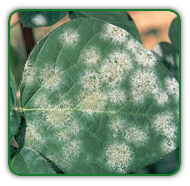 Plants that are susceptible to mildew, such as peas, pumpkin, zucchini and cucumber can benefit from a milk spray. Use full-cream milk and spray every few days on the leaves until the mildew is under control. Plants that are susceptible to mildew, such as peas, pumpkin, zucchini and cucumber can benefit from a milk spray. Use full-cream milk and spray every few days on the leaves until the mildew is under control.
If the small white patches of mildew are just starting, you should be able to catch it early and stop further spreading by using a diluted milk solution of equal parts water and milk.
If the situation is out of control, either remove the affected leaves or the whole plant and destroy it.
"Damping off" is caused by fungi such as Phtophtora and Pythium. Seedlings, like lettuce, suddenly collapse with the rot. Soggy conditions, overcrowding or too much peat in the mix can be the cause. Try letting the soil dry out on the surface in-between waterings, and even sprinkling a layer of sand on the surface.
Sand and a dry surface will also control "Fungus gnats." They are tiny little black midget type flies that crawl and fly around the surface of the soil. They lay their eggs and the larvae will damage seedling by eating their roots.
Chamomile tea is a fungicide. Prepare a cup of chamomile tea and allow it to steep for 10 minutes. Once cool it can be sprayed on the affected leaves, top and bottom.
Cinnamon powder sprinkled around plants and soil also controls fungus.
If you can make or buy good quality Compost tea, this is extremely beneficial. Compost tea balances the microbes and bacteria in the soil, thus fighting the disease organisms and providing active healthy organisms and fertiliser to strengthen plants and make them resistant to problems.
Moles (Also see Gophers & Voles)
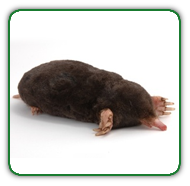 Moles eat insects and worms; they don't harm plants except by their earthworks. Moles eat insects and worms; they don't harm plants except by their earthworks.
Opossums
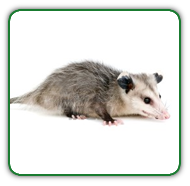 Opossum deterrents are many, with only anecdotal evidence that some work. Reliable tests do give credit to camphor to repel opossums. Mix natural camphor flakes or oil to a paste with something like Vaseline and rub around tree trunks, or put camphor in stocking leg or net bag and hang from a branch. Opossum deterrents are many, with only anecdotal evidence that some work. Reliable tests do give credit to camphor to repel opossums. Mix natural camphor flakes or oil to a paste with something like Vaseline and rub around tree trunks, or put camphor in stocking leg or net bag and hang from a branch.
If opossums just love your garden and fruit and veggies, it may be worth your while to fence them out. Use floppy but strong chicken netting just under 90cm (3ft) high supported on lengths of fencing wire that are curved outward at the top so those cheeky possums just get swung around when then try to climb up. Bury the netting 20cm (8") in the ground.
For fruit trees put a smooth, wide metal collar around the trunk to stop them climbing up.
Keeping chickens nearby may also deter opossums.
Scale
 It can be a shock to peer at a plant and realise that it's covered in black, brown or green scale. More of a shock will be when in a short while your plant starts turning up its toes in a stunted sort of way, so tackle scale as soon as you find it. Scale gathers on leaves and stems, sucking the life out of plants. It can be a shock to peer at a plant and realise that it's covered in black, brown or green scale. More of a shock will be when in a short while your plant starts turning up its toes in a stunted sort of way, so tackle scale as soon as you find it. Scale gathers on leaves and stems, sucking the life out of plants.
A black fungus called sooty mould grows on the sweet honeydew secretions from scale. This does the plants no good and looks awful. Ants also love scale honeydew and will aggressively farm scale to obtain as much as they can.
The odd scale can be scraped off with your nail, blunt knife or toothbrush. Always check a week or so later for any new ones.
Garlic fire spray also works, because it kills the crawling nymphs as well as smothering the waxy coated adults which permanently attach themselves to the plant.
Also mix 1/4 teaspoon of oil, 2 tablespoons baking soda and 1 tablespoon mild liquid soap in two gallons of water. Spray or wipe on plants once a week for 3 weeks or until gone.
Slugs
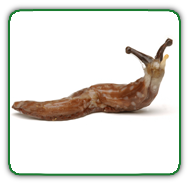 Do a night patrol as for snails. The best time is dusk especially when it's damp or raining. Don't use your hand to pick them up — it's horrendous trying to get that sticky stuff off. Scoop them up with an old spoon, dump them in a bucket and scrape them out somewhere where they won't be a pest. Do a night patrol as for snails. The best time is dusk especially when it's damp or raining. Don't use your hand to pick them up — it's horrendous trying to get that sticky stuff off. Scoop them up with an old spoon, dump them in a bucket and scrape them out somewhere where they won't be a pest.
If there's nowhere else for them but kapow... give them a quick stamp with your shoe, or salt sprinkled on snails and slugs will kill them instantly. Go out in the evening with a flashlight and protect your plants!
Sprinkle crushed egg shells around vulnerable plants. Slugs and snails will avoid crossing the sharp shells and it will enrich your soil with calcium. Children like to help here, they love crushing eggshells. Keep them in a jar until you have enough to use.
Another dislike of snails is sand, which they do not like to cross. Put a band of fine sand about 1cm (1/4") high around the garden edge or base of plants.
Sprays like Garlic fire don't work with slugs and snails — they are mollusks, not insects
Snails
 As for slugs mostly. Also put beer in a shallow pan in the garden to trap snails and slugs overnight. Vinegar in a shallow pan will do the same thing. As for slugs mostly. Also put beer in a shallow pan in the garden to trap snails and slugs overnight. Vinegar in a shallow pan will do the same thing.
Orange or grapefruit halves hollowed and turned upside down placed around the garden will also attract snails and slugs. Go out in the morning to remove or deliver the coup de grace on those hiding under the peel.
Spider mites
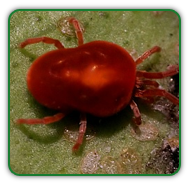 There are unknown millions of mite species, many similar to thrips. In the garden the two-spotted mite is commonly called red spider mite because in the cold weather it changes from pale green with two red spots to orange/red, looking like a miniature red spider. There are unknown millions of mite species, many similar to thrips. In the garden the two-spotted mite is commonly called red spider mite because in the cold weather it changes from pale green with two red spots to orange/red, looking like a miniature red spider.
Like thrips, spider mites suck the chlorophyll from the leaves of plants. Spider mites leave white translucent spots of damage and no dark droppings. In heavier infestations a silky web is obvious, which is secreted by the mites to protect themselves from enemies and poisons. These webs can cover a whole plant.
Natural predatory mites are the best control, so having compost and mulch to encourage beneficial mites will keep the right balance. Spiders, parasitic wasps, lady bugs and lacewings also feed on red spider mites.
Use a soap spray to eradicate these critters. Spray plants weekly until mites are gone, then monthly to stop them from returning. Also see other sprays under Caterpillars.
Thrips
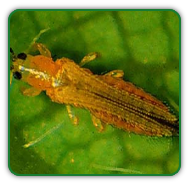 There is no singular word for thrips — such as a thrip. And look at one of their names Heliothrips haemorrhoidalis! So these horribly named beasties come by the gangload. There is no singular word for thrips — such as a thrip. And look at one of their names Heliothrips haemorrhoidalis! So these horribly named beasties come by the gangload.
Microscopic greenhouse thrips rasp away on the surface cells of leaves and suck out their chlorophyll contents. The hollowed, air-filled cells then take on a silvery, tissue paper look. This later turns brownish and crinkly and there are dark spots of thrips droppings seen.
Some thrips also spread viruses, such as the tomato spotted wilt virus. Not nice.
Keep weeds down if troubled with thrips, as thrips overwinter in nearby ground foliage waiting for their favourite plants the next season.
Garlic fire spray trips thrips up and there are a number of predatory bugs native to different countries. Lacewing larvae are a good biological control also.
Voles (Also see Gophers)
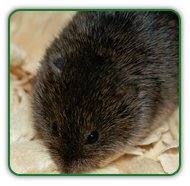 Unlike Moles, Voles only eat roots and bark rather than insects and worms. Electronic gadgets were popular once for organic garden pest control, but apparently have little success on Voles, so you might have to resort to mouse traps if you're desperate. Bait traps with bread or stiff porridge, then lay the traps on the vole trails, cover each trap with a box with a hole (to stop birds and possibly other animals, and kids) and keep checking and moving and replacing until you win! Unlike Moles, Voles only eat roots and bark rather than insects and worms. Electronic gadgets were popular once for organic garden pest control, but apparently have little success on Voles, so you might have to resort to mouse traps if you're desperate. Bait traps with bread or stiff porridge, then lay the traps on the vole trails, cover each trap with a box with a hole (to stop birds and possibly other animals, and kids) and keep checking and moving and replacing until you win!
Whitefly
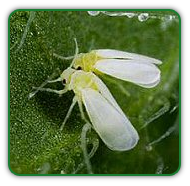 Windy conditions keep whitefly away temporarily, and also a strongish hose down will move them on. Detergent or oil coats their wings and stops them flying, so mix up approximately 1-2 teaspoons detergent to 1 litre (15oz) water, or half a cup of cheap salad oil to 1 litre water, with a dash of detergent. Spray all over infected plants, including underside of leaves if possible. Windy conditions keep whitefly away temporarily, and also a strongish hose down will move them on. Detergent or oil coats their wings and stops them flying, so mix up approximately 1-2 teaspoons detergent to 1 litre (15oz) water, or half a cup of cheap salad oil to 1 litre water, with a dash of detergent. Spray all over infected plants, including underside of leaves if possible.
Whitefly are attracted to yellow. Get some sticky stuff, such as vaseline, castor oil, natural gum resin, or vegetable wax. Tie bright yellow plastic bag bits coated with sticky stuff to stakes, or smear a yellow plastic bucket, or paint a nearby board the brightest yellow you can buy.
If necessary shake the whitefly off the plants then watch as they land on the yellow traps and get stuck.
See how simple organic garden pest control is?
You're the owner of those veggies doggone it, not those garden pests. So mix up a batch of whatever you need now and may the luck be with you.
Even with natural ingredients, don't get sprays in your eyes, or even touch your eyes with your hands after mixing up concoctions. Label sprays well and keep out of reach of children.
Always remember your community spirit towards those that co-share your garden and surrounds. Sometimes you may have to learn to live with a little wastage for you and the planet to stay healthy.
More organic garden pest control resources
Companion planting: Another important method to help control garden pests is companion planting.
Beneficial Garden insects and creatures: Here's how to attract these good critters to help with natural garden pest control
Natural Pest Sprays & Repellents: Here are some Natural Pesticide and Incesticides you can create and mix for yourself. |